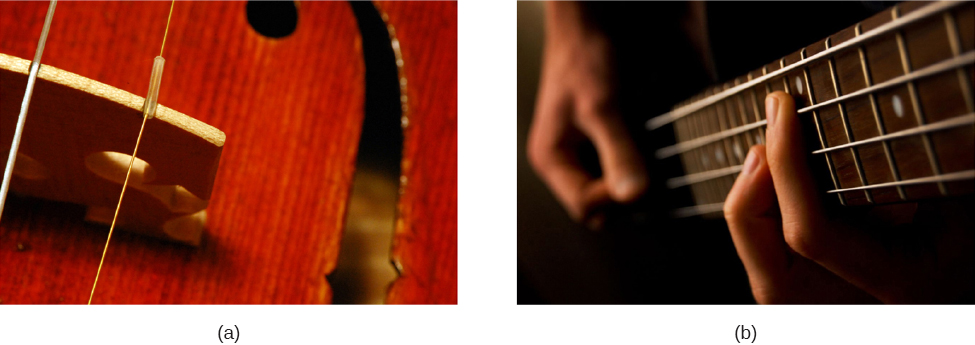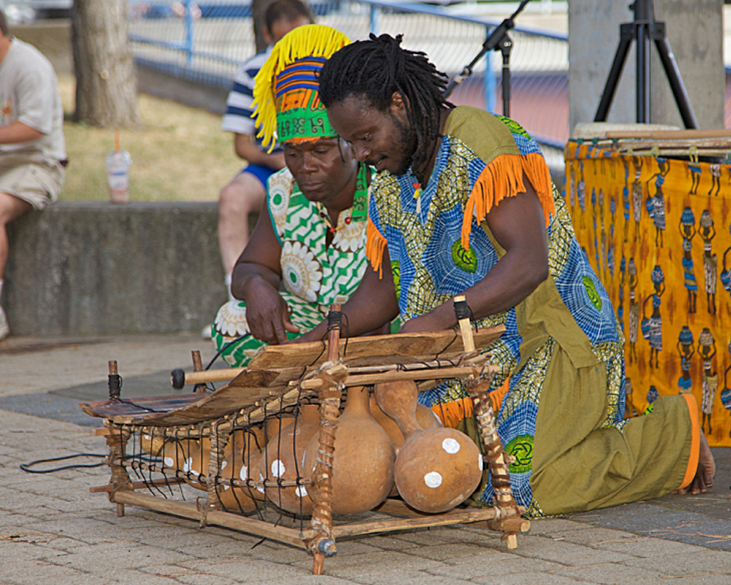| << Chapter < Page | Chapter >> Page > |


We have emphasized sound applications in our discussions of resonance and standing waves, but these ideas apply to any system that has wave characteristics. Vibrating strings, for example, are actually resonating and have fundamentals and overtones similar to those for air columns. More subtle are the resonances in atoms due to the wave character of their electrons. Their orbitals can be viewed as standing waves, which have a fundamental (ground state) and overtones (excited states). It is fascinating that wave characteristics apply to such a wide range of physical systems.
How does an unamplified guitar produce sounds so much more intense than those of a plucked string held taut by a simple stick?
Consider three pipes of the same length ( L ). Pipe A is open at both ends, pipe B is closed at both ends, and pipe C has one open end and one closed end. If the velocity of sound is the same in each of the three tubes, in which of the tubes could the lowest fundamental frequency be produced? In which of the tubes could the highest fundamental frequency be produced?
When resonating at the fundamental frequency, the wavelength for pipe C is 4 L , and for pipes A and B is 2 L . The frequency is equal to Pipe C has the lowest frequency and pipes A and B have equal frequencies, higher than the one in pipe C .
Pipe A has a length L and is open at both ends. Pipe B has a length L /2 and has one open end and one closed end. Assume the speed of sound to be the same in both tubes. Which of the harmonics in each tube would be equal?
A string is tied between two lab posts a distance L apart. The tension in the string and the linear mass density is such that the speed of a wave on the string is A tube with symmetric boundary conditions has a length L and the speed of sound in the tube is What could be said about the frequencies of the harmonics in the string and the tube? What if the velocity in the string were ?
Since the boundary conditions are both symmetric, the frequencies are Since the speed is the same in each, the frequencies are the same. If the wave speed were doubled in the string, the frequencies in the string would be twice the frequencies in the tube.
If a wind instrument, such as a tuba, has a fundamental frequency of 32.0 Hz, what are its first three overtones? It is closed at one end. (The overtones of a real tuba are more complex than this example, because it is a tapered tube.)
What are the first three overtones of a bassoon that has a fundamental frequency of 90.0 Hz? It is open at both ends. (The overtones of a real bassoon are more complex than this example, because its double reed makes it act more like a tube closed at one end.)
How long must a flute be in order to have a fundamental frequency of 262 Hz (this frequency corresponds to middle C on the evenly tempered chromatic scale) on a day when air temperature is ? It is open at both ends.
What length should an oboe have to produce a fundamental frequency of 110 Hz on a day when the speed of sound is 343 m/s? It is open at both ends.
1.56 m
(a) Find the length of an organ pipe closed at one end that produces a fundamental frequency of 256 Hz when air temperature is . (b) What is its fundamental frequency at ?
An organ pipe is closed at both ends. Compute the wavelengths and frequencies of the first three modes of resonance. Assume the speed of sound is
The pipe has symmetrical boundary conditions;
An organ pipe is closed at one end. Compute the wavelengths and frequencies of the first three modes of resonance. Assume the speed of sound is
A sound wave of a frequency of 2.00 kHz is produced by a string oscillating in the mode. The linear mass density of the string is and the length of the string is 1.50 m. What is the tension in the string?
Consider the sound created by resonating the tube shown below. The air temperature is . What are the wavelength, wave speed, and frequency of the sound produced?

A student holds an 80.00-cm lab pole one quarter of the length from the end of the pole. The lab pole is made of aluminum. The student strikes the lab pole with a hammer. The pole resonates at the lowest possible frequency. What is that frequency?
A string on the violin has a length of 24.00 cm and a mass of 0.860 g. The fundamental frequency of the string is 1.00 kHz. (a) What is the speed of the wave on the string? (b) What is the tension in the string?
By what fraction will the frequencies produced by a wind instrument change when air temperature goes from to ? That is, find the ratio of the frequencies at those temperatures.
1.03 or

Notification Switch
Would you like to follow the 'University physics volume 1' conversation and receive update notifications?